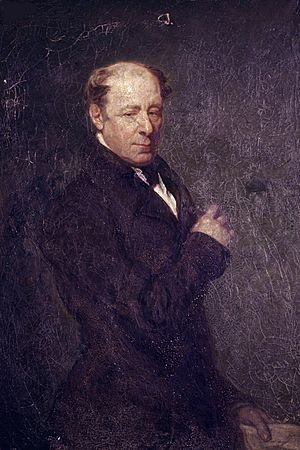Robert Seppings facts for kids
Sir Robert Seppings (1767–1840) was a very important English ship designer. He was a member of the Royal Society. His clever ideas helped make ships much stronger. He used a special way of building ships with diagonal supports. Because of his great work, he became the main ship designer for the British Navy in 1813. He held this important job until 1835.
Contents
Robert Seppings' Early Life and Inventions
Robert Seppings was born in a town called Fakenham, England. This was on December 11, 1767. When he was about 15, in 1782, he started learning how to build ships. He worked at a place called Plymouth Dock.
Seppings Blocks: A Smart Repair Idea
By 1800, Robert had become a skilled ship builder. He invented a very smart way to fix ships. Before his idea, repairing the bottom of a ship was very slow. Ships had to be carefully lifted in a dry dock. A dry dock is like a big basin that can be drained of water.
Robert's new idea used special supports called "Seppings Blocks." These blocks held up the ship's keel. The keel is the main beam along the bottom of a ship. These blocks were made so they could be easily removed. This meant workers could quickly get to the entire bottom of the ship. It saved a lot of time and effort. The Navy was very impressed. They paid him £1000 for his invention. In 1804, he got a promotion. He became a master ship builder at Chatham.
How Seppings Made Ships Stronger
At Chatham, Robert kept coming up with new ideas. Even though some people didn't like new ways of doing things, he made big changes. He improved how the front (bow) and back (stern) of ships were designed. But his biggest change was using "diagonal bracing" inside the ship's hull. The hull is the main body of the ship.
Diagonal Bracing: A Game Changer
Robert first tried diagonal bracing in 1800. He added these supports to a ship called HMS Glenmore. Then, in 1805, he used this method on a larger warship. This was the 74-gun ship HMS Kent.
Using diagonal supports made the ship's hull much stiffer. This meant the ship could handle rough seas better. It also allowed builders to make longer ships. Before, long ships would "hog." This means the ends of the ship would droop down. Diagonal bracing stopped this problem.
Stronger hulls also helped the ship's rigging. Rigging is the ropes and chains that support the masts and sails. With a stiffer hull, the rigging had better anchor points. This helped the ship in strong winds. It also reduced "working" of the hull. Working happened when the ship's parts moved and rubbed in rough seas. This would open gaps between the wooden planks. Water would then leak in. Robert's design helped stop these leaks.
Using Iron in Ship Building
Robert Seppings also helped introduce iron parts into ship construction. This was important because special "grown timbers" were becoming hard to find. Grown timbers were pieces of wood that had to be grown into specific shapes, like curved "knees," to give the ship strength. Using iron helped solve this problem.
These stronger ship designs had many benefits. They protected the crew better from enemy fire. They could carry more powerful weapons. And ships could stay at sea longer in bad weather. This was because the stronger hull resisted damage. It also reduced leaks and salt water damage. Salt water was especially bad for ships where wood and iron touched.
Later Life and Recognition
In 1813, Robert Seppings became a joint Surveyor of the Navy. This was a very high position. He shared the job with Joseph Tucker. He kept this role until he retired in 1832.
Robert Seppings was recognized for his amazing work. He received a special honor called a knighthood in 1819. This meant he was called "Sir Robert Seppings." He passed away in Taunton on April 25, 1840.


